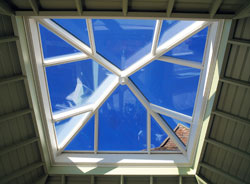Improve Your Home with a Roof Lantern
It’s not often that a design eyesore can be transformed into a desirable feature virtually overnight – but adding a simple roof lantern to a flat roof can do just that.

Though they are quick to install and affordable, roof lanterns have a dramatic effect, bathing the room below in light and creating a sense of spaciousness. Available in a range of shapes including the rectangular hipped roof design, a dome, pyramid or octagon, a roof lantern combined with new eaves, fascias and gutters also improves the external appearance of the roof.
According to leading south east conservatory supplier Glass Houses by Jeremy Uglow, the market for roof lanterns is growing fast, with architects and designers often including them in plans for homes and offices. “They’re increasingly used in new extensions as well as in existing structures,” said Jeremy Uglow. “The conservatory market generally is moving away from the concept of a glass box attached to a house towards orangeries, with a greater ratio of solid material to glass, making it easier to control temperature.
“A roof lantern, which is a glass and timber structure, is a good alternative when a client doesn’t want a full conservatory or orangery and where a conventional extension would rob light. They add light without the over-heating which can be a problem with conservatories”.
“They are also useful where there are planning restrictions related to the height of an extension. Though they are much used for flat roofs – and the most popular design is the rectangular, hipped roof lantern with a symmetrical margin of ceiling around the perimeter – they can also be incorporated into the ridge of a roof. A well-designed lantern works particularly well over dark stairwells, landings and halls and in loft extensions, bringing light and a more welcoming atmosphere. They can be positioned to define and illuminate a particular area within a space – a kitchen island, for example, or the dining area within an open-plan kitchen/diner.”
At home in a minimalist, contemporary setting, roof lanterns integrate equally well with period properties. Indeed they were first used in wealthy homes during the Georgian period and were popular throughout the Victorian and Edwardian eras. Period homes with shallow pitched roofs surrounded by parapet walls present particularly good potential to create an orangery effect with a roof lantern, according to Jeremy.
While the roof lanterns of the past were prone to leakage, modern techniques and high performance materials make today’s double glazed designs durable and low-maintenance with good insulation properties. Glass Houses uses 24mm toughened low E glass as standard in its roof lanterns and recommends UV filter for south facing rooms, with self cleaning coatings and automatic opening systems optional. Joinery is factory finished with three coats of microporous paint.
The company has developed its expertise in glass roof design and manufacture during over 20 years in the industry. Roof lanterns – like conservatories and orangeries – are designed to each client’s individual specification and hand-built by craftsmen in the company’s own workshop in Farnham using hardwood from managed forests. They are delivered to the client fully assembled and can often be installed into a pre-prepared roof within four hours. Even a large lantern should not take more than a day to install.

The service provided by Glass Houses includes the design and preparation of drawings, manufacture and installation. If clients provide dimensions, a quotation can usually be provided over the telephone or by email.
For more information contact Glass Houses by Jeremy Uglow on 01420 520009, visit the website at http://www.glasshouses.com or email design@glasshouses.com
Ends
Glass Houses by Jeremy Uglow
The Workshop
Blacknest Works
Hampshire
GU34 4PX
Tel: 01420 520009
Fax: 01420 520463
